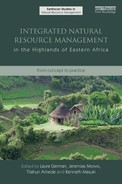ANNEX I
Program management and governance
Introduction
AHI's complex structure and accountability channels demanded that due attention be given to the program's governance. As stated earlier, AHI was, for most of its history, both an ASARECA network1 and a CGIAR ecoregional program convened by ICRAF. Program management is shared by the AHI regional office, AHI implementing partners, AHI Steering Committee and AHI stakeholders.
AHI site teams and national focal points
AHI site teams are composed of a site coordinator and a group of between seven and ten research and development specialists from different disciplines and organizations. The site coordinator and site team members are employees of national research and extension organizations in each partner country. They are responsible for coordinating and facilitating all activities in AHI benchmark sites, in partnership with partner organizations and the regional office. National focal points within National Agricultural Research Institutes are responsible for providing coordination between AHI and national research programs, and for monitoring team performance.
Regional research team
Everyday management of the program falls under the Regional Coordinator, administrative staff and a small regional research team. The regional research team (RRT) collaborates with and supports site teams directly in the field through structured exchanges (for joint learning) and technical follow-up. Each RRT member is responsible for an AHI research theme around which his/her interactions with site teams and partners is structured. They are also responsible for fostering methodological innovation and lessons learning regionally around their assigned theme.
A technical support group (TSG) comprised of the RRT and site coordinators assists the Regional Coordinator in ensuring high-quality implementation and technical outputs, agrees on annual work plans and budgets, and guides the overall technical direction of AHI.
AHI steering committee
The major task of the Regional Steering Committee (RSC) is to provide strategic direction and technical support to the network. The AHI RSC is the highest body governing the program and comprises the Director General of host country research institutes (or his/her designate), AHI site coordinators, representatives from partner International Agricultural Research Centres (IARCs), selected donor representatives, and the Executive Secretary of ASARECA. The RSC is chaired on a rotational basis by host NARI representatives.
AHI partners and stakeholders
AHI has worked with a broad range of partner institutions at different stages of program evolution, depending on the nature of work being done. These include: NARS and extension organizations in ASARECA member countries; International Agricultural Research Centres (ICRAF, CIAT, CIP, IFPRI); NGOs (IUCN, Eco-agriculture Partners, Lishe Trust, Africare, Action-Aid, Care International); local government; networks (African Mountain Forum, the International Mountain Forum, Landcare International, Mountain Research Initiative); and universities inside and outside the ASARECA region (Makerere University, Wageningen University, Uppsala University).
A broader set of stakeholders is also involved in the governance, management, and implementation of AHI. These include farmers in AHI benchmark sites; district institutions (NGOs, CBOs, and local government); national, regional, and international institutions; and donor organizations. These stakeholders are either beneficiaries of the different AHI products, provide strategic direction and financing, or provide in-kind support to project implementation. Local communities provide labour and land for testing of approaches and methods in INRM, while district institutions participate in scaling out and up approaches, backstopping farmers, and providing in-kind support. Other AHI stakeholders provide funding or participate in scaling up INRM.
Note
1 This was true until September, 2007 when ASARECA reorganized from 17 networks to 7 programs. Some of the activities that were undertaken by AHI were relocated to the new NRM program of ASARECA. However, AHI has maintained its mandate as a CGIAR ecoregional program convened by ICRAF.
